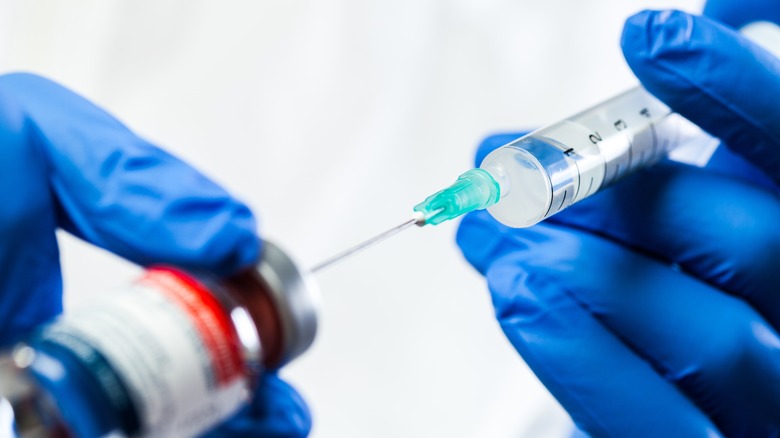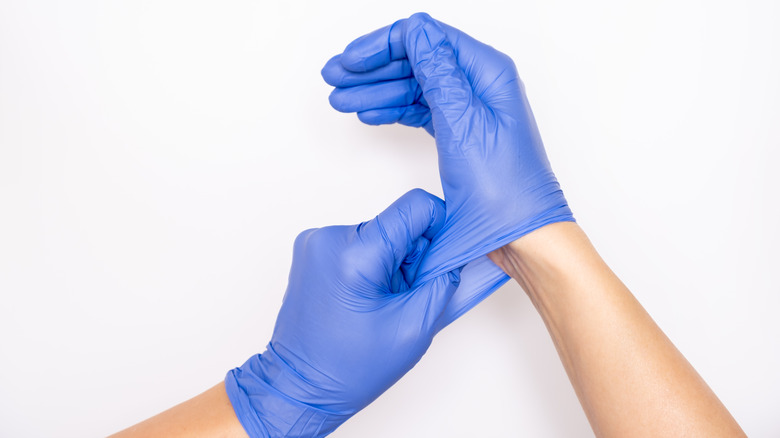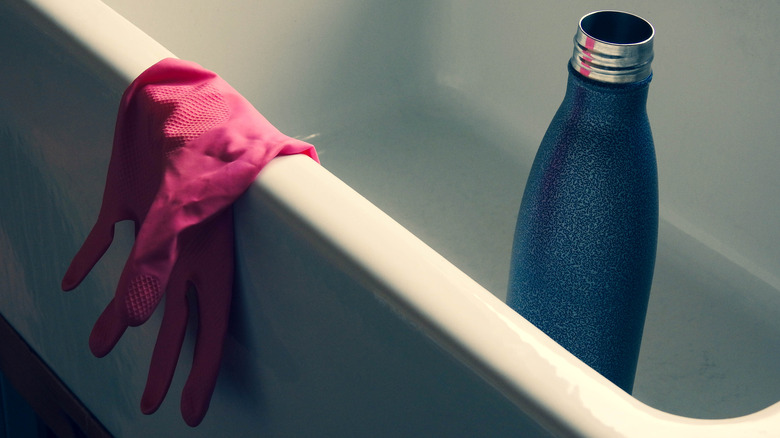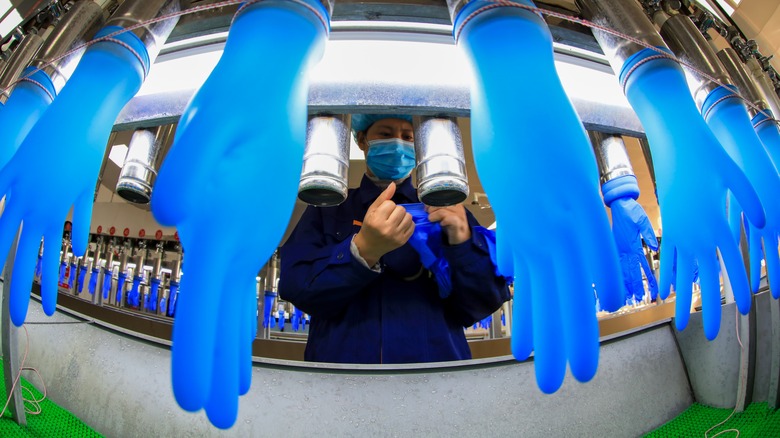Nitrile Vs. Latex Cleaning Gloves: What's The Difference?
Unless you're having nightmares after watching the Science Channel's "How It's Made" episode on rubber gloves, you probably don't think more about them than you need to. And it's possible that assuming you don't have a latex allergy, you never think about what they're made of at all. But there are a handful of different materials from which gloves are made, and they vary enough that it's probably worth thinking through before buying your next pair of dishwashing or general cleaning gloves.
In the '80s, Latex dominated the disposable gloves market. According to London-based rubber supplier Corrie MacColl, this included about 85% of the medical market. So when demand exploded at the end of the eighties in the midst of the AIDS epidemic, companies rushed inferior quality gloves to market. Those gloves often included high levels of extractable proteins that are normally removed during the manufacturing process, causing a jump in the number and severity of latex allergies.
Today, latex's main alternative, nitrile, has around 72% of the global disposable glove market share (via Grand View Research). Medical use again exploded, this time with the coronavirus pandemic, and the healthcare industry was responsible for almost 88% of the global revenue share by the end of 2021. But, some argue, latex is due for a comeback because latex gloves manufactured with modern practices can cause fewer allergic reactions. The gloves market is expected to grow throughout the 2020s, and rubber manufacturers are repositioning themselves to be part of that growth. But the real question is, which material is right for you?
What are latex and nitrile, anyway?
According to Britannica, natural rubber gloves come from the rubber tree Hevea, which is tapped to obtain latex. Nitrile, a synthetic rubber, is manufactured through a chemical process. Together they make up many cleaning gloves sold throughout the world.
Natural rubber latex is refined from tree sap by being purified, concentrated, and modified, according to the procurement portal ThomasNet. The process results in a material that is tough, elastic, and good as a barrier against certain pathogens. Because latex is a natural material, it contains proteins, comprising 1-1.5% of the material, most of which is present in the serum that holds the desirable hydrocarbons in suspension (via the Journal of Allergy and Clinical Immunology). These are removed by an extraction process that is incomplete, leaving behind proteins that are allergenic for some users. If we were able to remove 100% of these proteins, reactions from "latex allergies" would not occur. Because of its characteristics, latex is used in many other products, from condoms and balloons to catheters.
Nitrile gloves are made through a chemical process from butadiene molecules (via Sunline Supply). This results in a durable material suitable for latex allergy sufferers while allowing for a better fit than vinyl options. Nitrile provides superior protection against oil-based substances, chemicals, and viruses. Most people are familiar with nitrile as a blue medical exam glove, but it is used in many industries and comes in a wide range of colors (via Your Glove Source). Automotive technicians often use orange nitrile gloves to help them see better in dark crannies, and black gloves are typically used by law enforcement personnel and postal workers.
The characteristics of latex and nitrile gloves
It's easiest to think about the characteristics of latex and nitrile by thinking about disposable medical or industrial gloves, which have fewer supporting elements. And nitrile and latex aren't the only players, by a long shot. Polyethylene, neoprene, and vinyl gloves also have their places in the market.
The defining qualities of medical gloves are evident in the FDA standards that apply to them, says Sunline Supply. These standards regulate the durability and acceptable defect rate of medical gloves. Gloves with higher defect rates are relegated to mechanical and industrial uses. Gloves may also be chemo-rated as chemotherapy drugs can permeate some gloves. Latex is comfortable, inexpensive, and has a short shelf life, while nitrile is somewhat less comfortable and highly puncture-resistant. Perhaps most importantly, it also functions as a good barrier against chemicals, oils, and acids.
Some gloves are suitable for sterile applications, like surgery, while others don't have a high enough quality rating to be used in sterile environments. For example, some options are powdered with cornstarch to help with putting them on. However, these powdered gloves are increasingly thought of as inappropriate for medical use and have largely been banned in the field by the FDA (via Federal Register). The thickness of a glove obviously relates to its durability and puncture resistance, as does the tensile strength of the material. A randomized controlled trial found that single gloves are perforated 8.9% of the time during surgical use (via the American Journal of Surgery). However, when two pairs were worn the inner glove was never perforated. So in some cases, the best way to improve glove strength might be to wear two sets of gloves.
Types and uses of cleaning gloves
There are dozens of uses for disposable latex and neoprene gloves, and different formulations to match. However, many people tend to buy a single pair of household cleaning gloves for everyday chores. Reusable cleaning gloves inherit some of their properties from the materials they're made from, and some from the design and manufacture of the individual brands.
Gloves for home use share some purposes with disposable medical gloves, such as serving as a barrier to potentially harmful chemicals, says The Disaster Company. And they have some other purposes not necessarily common for disposable gloves, such as resistance to heat and protection of sensitive skin from hot water, a common need for users of dishwashing gloves. The hot water and harsh cleaning chemicals can remove natural oils from your skin and leave them susceptible to damage. They can similarly affect your fingernails, which can break and crack due to exposure. For some applications, like cleaning bathrooms or dealing with difficult-to-remove substances like grease, you might choose disposable gloves over reusable cleaning gloves, or establish a thorough cleaning and sanitization regimen.
In GearLab's review of everybody's favorite cleaning glove, Casabella, you find a good list of qualities that can help you distinguish one cleaning glove from another. Consider the comfort, length, and fit of the gloves as well as the quality of the lining. The texture is also important — particularly to avoid slipperiness — and cut and puncture resistance are ideal for doing the dishes. Many of these qualities are impacted by the choice of latex, nitrile, or another material.
The ins and outs of nitrile gloves
Nitrile gloves have an impressive list of features, according to The Glove Company. They're waterproof, oil and greaseproof, and exceptional at puncture resistance. They are also free of problematic chemicals like BPA and phthalates, and notably of latex. Nitrile is, of course, quite good at staying impermeable to many chemicals. They will, however, become somewhat less reliable over time, particularly if exposed to heat or sunlight. Nitrile outperformed latex, neoprene, and PVC when their permeability was tested against substances with extremely high or low pH values (via Safety Science). Because of these properties and because nitrile is less form-fitting and soft than latex, nitrile gloves are trending toward being thinner and thinner (via Your Glove Source). Since the gloves have superior qualities for chemical resistance, the metric most likely to be hurt by decreased thickness, there is generally room to make them thinner without falling below the permeability ratings of their competition.
In terms of environmental impact, nitrile is good but somewhat less ideal than latex. Nitrile will biodegrade eventually, but it might be several generations down the road (via Lab Manager). There are efforts to mitigate this problem. GREEN-DEX gloves, for example, will break down in one to five years. Many standard recycling programs will accept nitrile gloves, so long as they are not biohazardous or otherwise contaminated with toxins (via Gloves.com). To ensure efficient recycling, businesses can form partnerships with companies like Medline and Kimberly-Clark that offer glove-specific recycling programs.
The ins and outs of latex gloves
Because of the problems caused by latex allergies, makers of synthetic gloves have tried to match the various qualities that latex glove users appreciate. According to The Journal of Allergy and Clinical Immunology, latex has great barrier properties, strength, elasticity, tactile sensitivity, comfort, and durability. On the other hand, a Safety Science pH study found that latex was the worst performer, failing to contain acids and alkalis more than twice as fast as nitrile. However, Corrie MacColl claims that natural rubber latex features a stronger resistance when exposed to strong acids and alkalis. Latex certainly offers better tear resistance, which should be unsurprising given the material's elasticity. Notably, the durability of the glove also contributes to the superior fit and lower incidence of hand fatigue among latex wearers.
Synthetics have only made inroads in some of these areas. However, latex is still a prevalent material that's used in a wide variety of applications. Fortunately, better manufacturing processes for natural rubber latex gloves have been able to dramatically reduce protein levels and, therefore, allergic reactions. (via the Journal of Allergy and Clinical Immunology).
Nitrile and latex allergies
It would be easy to assume that nitrile is a compromise that eliminates the concern about allergies at the expense of a few other qualities. However, as Your Glove Source points out, nitrile doesn't manage to fully eliminate allergy issues. Accelerators used in the production of nitrile can have serious consequences for users who are allergic to them. But the allergy rate is far less than latex allergies, and the development of accelerator-free nitrile gloves has eliminated this concern for their users.
Obviously, the biggest problem with latex is the incidence of allergies, which is an issue for a significant number of people (via Journal of Occupational Health). There remains a wide variation in levels of non-extracted allergenic proteins in latex gloves. The incidence of latex allergies is 4.3% in the general population but 9.7% of healthcare workers, a field where exposure can be more likely. The 1998 German ban on high-allergen latex gloves, reported by the International Archives of Occupational and Environmental Health, has led to a 97% reduction in latex allergy reports (via Corrie MacColl). As a result, efforts to further reduce the number of extractable proteins in latex gloves might be effective at eliminating the allergy concern, but there's little reason to expect nitrile to lose its market advantage any time soon.
The real-world experience of latex and nitrile gloves
A lot of people in a number of industries like medicine, auto care, and law enforcement spend much of their day in nitrile or latex disposable gloves. However, the experience of using household cleaning gloves is quite different because the construction of the gloves is often different from that of disposables. The most obvious difference is that household cleaning gloves tend to be thicker than disposable gloves. They also often have a flocked lining for comfort and to make putting them on and removing them easier, according to Lowe's. The lining also absorbs sweat, which contributes mightily to making the gloves more comfortable (via food service distributor Hubert).
Many household gloves consist of several layers and a textile base, to improve durability. It's also important to match your gloves to your task because chemical resistance is a function of the thickness and material that your gloves are made of. Thickness can improve protection from hot water, which can strip oils from your skin. These construction factors all add up to less softness, flexibility, and tactile sensitivity, so cleaning gloves aren't always useful for other tasks that require a high level of touch and dexterity.
A strategy employed by some is to use cleaning gloves for most tasks while using disposables (or retired cleaning gloves) for particularly unpleasant or difficult jobs (via Medrux). You might use disposable gloves for jobs where you come in contact with unpleasant or difficult-to-remove substances, like grease or your cat's litter box contents. It might also make sense to use disposable gloves for jobs that require a lot of touch sensitivity or intricate motor skills.
Cleaning your cleaning gloves
When you're done washing your dishes, toilets, your range's vent hood, and the refrigerator's coils, the last thing you probably want to do is clean your gloves, but that's the time to do it. The process is simple enough, but there are some ways to make sure you don't end up spreading germs instead of cleaning them up. Gloves.com outlines a simple process: While you're still wearing them, wash your gloves with mild detergent and water. Use friction between the gloves, or a cloth, to remove soil as necessary. Rinse them in running water, then remove them and wash your hands. Turn the gloves inside-out and soak them in soapy water, then hang them to dry in a place with plenty of airflow. Once they're dry, you can fold them and store them in a dry place.
Research shows that disposable medical gloves can be effectively disinfected (via Materials Today Sustainability), but common household disinfection methods might not achieve the same results. Rachel Khong at New York Magazine's The Strategist improves sanitation and cleanability of gloves by eventually demoting pairs of dishwashing gloves to bathroom duty. Another obvious implication of this approach is that it's a good idea to keep gloves for such tasks separate, having at least one pair for each zone.
Summary: pros and cons of both
So, when to use nitrile and when to use latex cleaning gloves? As we've seen, the two materials have different strengths and weaknesses, though they're becoming more and more similar over time.
While nitrile alleviates concerns about latex allergies and boasts better chemical, solvent, and puncture resistance according to Your Glove Source, they are less form-fitting and not as soft as latex, which reduces dexterity and sensitivity to touch. Many users still prefer to rely on the familiarity of latex and even PVC options. In Gear Lab's ratings, for example, the highest-ranked glove made predominantly from nitrile placed 10th. Latex gloves, on the other hand, are far more readily biodegradable, more elastic, provide better finger sensitivity, and are safe for extended wear (via Webstaurant Store). However, they're pricier than vinyl options. Of course, they can also cause reactions in allergy sufferers.
If latex allergies aren't an issue for you or anyone who might be affected by your glove choice, it probably makes the most sense to shop for gloves based on individual brands' qualities and reviews. If you do, you'll be more likely to end up with latex than nitrile ... or a combination of the two.









